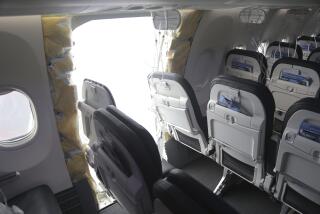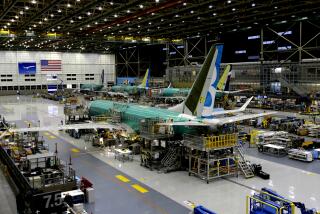New Parts Urged for 1,900 McDonnell Douglas Planes
WASHINGTON — As a safety precaution, more than 1,900 aging McDonnell Douglas airliners should have critical parts replaced or modified at a cost of about $563 million, with most of the work being done over the next 10 years, a government-industry task force said Monday.
The Federal Aviation Administration is expected to begin the process of issuing repair orders for 1,153 U.S.-registered aircraft later this week, affecting fuselages, landing gears, doors and other parts of early models of the DC-8, DC-9, MD-80 and DC-10.
More than 750 planes registered to foreign carriers probably will face repair directives from an international agency, a spokesman for the Air Transport Assn. said.
Similar action was taken on older Boeing passenger jets last May as part of a dramatic change in philosophy for maintaining the airworthiness of aging aircraft. Instead of simply requiring regular inspections of planes for signs of metal fatigue, the FAA is requiring modifications when they have reached a certain age or have made a certain number of flights, regardless of what the inspections show.
The new philosophy emerged after the accident last year in which a stewardess was sucked out of a 19-year-old Aloha Airlines Boeing 737 that lost an 18-foot section of its fuselage. After the incident over Hawaii, industry and government formed joint task forces to recommend ways “to increase safety margins,” in the words of coordinator Clyde Kizer of the Air Transport Assn.
75,000-Landing Standard
Modifications to the McDonnell Douglas planes will be made as an aircraft reaches a “threshold” of about 75,000 landings. In the next four years, only about 100 planes will cross that threshold, but the bulk of the 1,900 airliners in the fleet will cross it in the following six years. A relative few will undergo repairs in the subsequent 10 years, FAA and industry officials said.
It is hoped that the impact on airline fares and service will be negligible, Kizer said.
“The intent is to provide enough lead time so that airlines could schedule these modifications into their normal maintenance programs,” he said. “Also, programming the changes, instead of doing it by find-and-fix, should reduce costs. Of course, you never know when you open a plane up what you will find in areas you have never looked. But we don’t anticipate finding any surprises.”
On the other hand, the economic impact on individual airlines and other owners of affected aircraft could vary widely, depending on the age of planes in their fleets and the quality of their maintenance programs, industry analysts said.
Could Harm Small Firms
“The airlines would have been doing these things for some time under existing FAA service bulletins,” said Paul Turk of Avmark Inc. of Arlington, Va., an aviation management consulting firm. “But I can see charters with DC-8s or small package operators with older DC-9s getting stung.”
Based on task force recommendations, the FAA will issue proposed “airworthiness directives” that will become permanent after about three months of public comment. Officials said none of the targeted aircraft apparently require immediate repairs.
The proposed directives call for 52 modifications to critical structures in the DC-8, costing about $161,000 per aircraft; 52 in the DC-9, costing $490,000, largely because of expensive landing gear modifications; 22 in the MD-80, costing $90,000, and 33 in the DC-10, costing $74,000.
McDonnell Douglas officials termed the number of required service actions relatively small, considering that the task force reviewed more than 3,900 possibilities.
“The formation of the industry-government task force on airworthiness assurance is one of the best things that has happened in the aviation industry in the last 30 years,” said Dale Warren, a vice president for Douglas Aircraft Co. of Long Beach, a unit of McDonnell Douglas, which is based in St. Louis.
Other Aircraft Makers
Another task force will make recommendations later this year for aircraft built by Lockheed, Airbus, British Aerospace Corp. and Fokker.
Kizer said the modifications recommended for McDonnell Douglas planes were similar to those for Boeing, with two major exceptions. On the Boeing 747, heavy structural material will have to be replaced in the nose section. And on the Boeing 727 and 737, major repairs will have to be made on fuselage lap joints--the source of disintegration in the Aloha accident.
Speaking at a news conference on the McDonnell Douglas recommendations, Kizer said that “none of the problems we have identified are present today. We are taking action to prevent their occurrence mostly in a 4- to 10-year time frame down the line.”
The Troubled Planes U.S.-registered McDonnell Douglas planes facing modifications. DC-8 Number of planes: 218 Modifications to each plane: 52 DC-9 Number of planes: 568 Modifications to each plane: 52 MD-80 Number of planes: 173 Modifications to each plane: 22 DC-10 Number of planes: 194 Modifications to each plane: 33 SOURCE: Federal Aviation Administration
More to Read
Inside the business of entertainment
The Wide Shot brings you news, analysis and insights on everything from streaming wars to production — and what it all means for the future.
You may occasionally receive promotional content from the Los Angeles Times.










